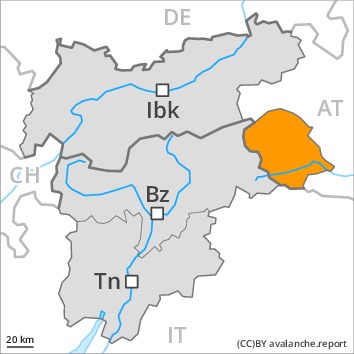
Danger level
 | treeline
|
Avalanche Problem
 | | Wind-drifted snow |
|  | |  |
 | | Persistent weak layer |
|  | |  |

A sometimes treacherous avalanche situation will prevail. Wind slabs and weakly bonded old snow require caution.
Older wind slabs can be released by a single winter sport participant in particular on west to north to east facing aspects above the tree line.
Dry avalanches can additionally be released in near-surface layers by small loads, caution is to be exercised on steep slopes also below the tree line. Whumpfing sounds and the formation of shooting cracks when stepping on the snowpack can indicate the danger. Meticulous route selection is important.
In the south the avalanche prone locations are more prevalent.
Snowpack
dp.6: cold, loose snow and wind
dp.8: surface hoar blanketed with snow
Some snow will fall. The new snow and wind slabs are lying on soft layers in all aspects and in all altitude zones. The new snow-covered wind slabs are lying on surface hoar in some places. As a consequence of low temperatures the snowpack can not consolidate.
Towards its base, the snowpack is well consolidated.
Tendency
A sometimes treacherous avalanche situation will prevail.
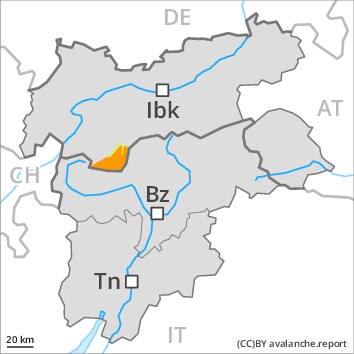
Danger level
 | treeline
|
Avalanche Problem
 | | Wind-drifted snow |
|  | |  |
 | | Persistent weak layer |
|  | |  |

The current avalanche situation calls for experience and restraint.
On wind-loaded slopes a sometimes unfavourable avalanche situation will prevail. The fresh and somewhat older wind slabs can be released by a single winter sport participant in some cases in all aspects. Caution is to be exercised in particular adjacent to ridgelines and in gullies and bowls above the tree line. Mostly the avalanches are medium-sized. The number and size of avalanche prone locations will increase with altitude.
Snowpack
dp.6: cold, loose snow and wind
dp.8: surface hoar blanketed with snow
Some snow will fall. Isolated avalanche prone weak layers exist in the top section of the snowpack at high altitudes and in high Alpine regions. The wind slabs are lying on soft layers. They are lying on surface hoar in some places. Towards its base, the snowpack is well consolidated.
Tendency
Fresh and older wind slabs are to be assessed with care and prudence.
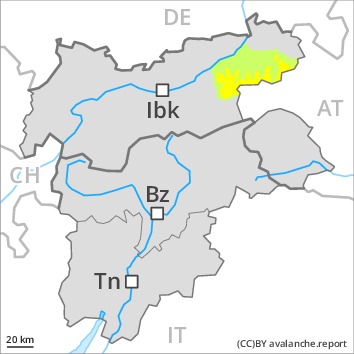
Danger level
 | treeline
|
Avalanche Problem

Wind slabs require caution.
Wind slabs are in some cases prone to triggering above the tree line, especially on very steep shady slopes adjacent to ridgelines. Mostly avalanches are only small but can be released also by a single winter sport participant. The prevalence of avalanche prone locations and likelihood of triggering will increase with altitude.
Snowpack
dp.6: cold, loose snow and wind
Some snow will fall. In some places wind slabs are lying on soft layers, especially on shady slopes at high altitude. Only a small amount of snow is lying for the time of year.
Tendency
The avalanche danger will persist.
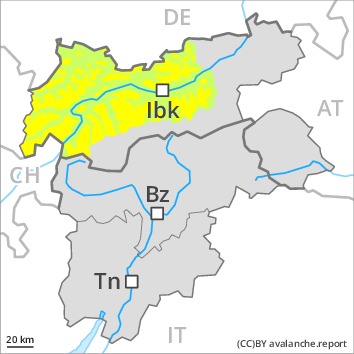
Danger level
 | 2200m
|
Avalanche Problem
 | | Persistent weak layer |
|  | |  |
 | | Wind-drifted snow |
|  | |  |

Wind slabs and weakly bonded old snow require caution.
Weak layers in the lower part of the snowpack can be released especially by large additional loads. This applies in particular on very steep shady slopes above approximately 2200 m, as well as at transitions from a shallow to a deep snowpack, when entering gullies and bowls for example. In some cases the avalanches are medium-sized.
In addition the fresh wind slabs should be taken into account. They can be released by a single winter sport participant especially on steep shady slopes at high altitudes and in high Alpine regions, caution is to be exercised in particular adjacent to ridgelines and in gullies and bowls. The avalanches are rather small.
Snowpack
dp.1: deep persistent weak layer
dp.6: cold, loose snow and wind
Some snow will fall. In some places various wind slab layers are lying on soft layers. They are lying on surface hoar in some places.
Steep shady slopes high altitudes and the high Alpine regions: Towards its base, the snowpack consists of faceted crystals. The old snowpack will be prone to triggering in some places.
Tendency
The avalanche danger will persist.

Danger level
 | 2200m
|
Avalanche Problem
 | | Wind-drifted snow |
|  | |  |
 | | Persistent weak layer |
|  | |  |

The current avalanche situation calls for experience in the assessment of avalanche danger.
The fresh and somewhat older wind slabs can be released, especially by large additional loads,. Caution is to be exercised in particular adjacent to ridgelines and in gullies and bowls above approximately 2200 m. Mostly the avalanches are medium-sized. The number and size of avalanche prone locations will increase with altitude.
Weakly bonded old snow requires caution. Weak layers in the upper part of the snowpack can still be released in some place by winter sport participants in particular on steep sunny slopes. This applies in particular between approximately 2300 and 2600 m.
Snowpack
dp.6: cold, loose snow and wind
dp.4: cold following warm / warm following cold
Some snow will fall. Isolated avalanche prone weak layers exist in the top section of the snowpack at high altitudes and in high Alpine regions. The wind slabs are lying on soft layers. They are lying on surface hoar in some places. Towards its base, the snowpack is well consolidated.
Tendency
Fresh and older wind slabs are to be assessed with care and prudence.
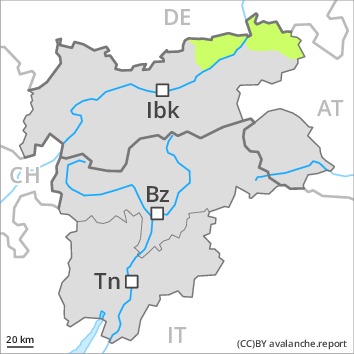
Danger level

Low, level 1.
Wind slabs require caution. This applies on very steep shady slopes, and adjacent to ridgelines above approximately 2000 m. The avalanche prone locations are rare and are easy to recognise.
Snowpack
dp.6: cold, loose snow and wind
Some snow will fall. The older wind slabs are lying on soft layers, especially on shady slopes at elevated altitudes. From a snow sport perspective, in most cases insufficient snow is lying.
Tendency
Low, level 1.




















